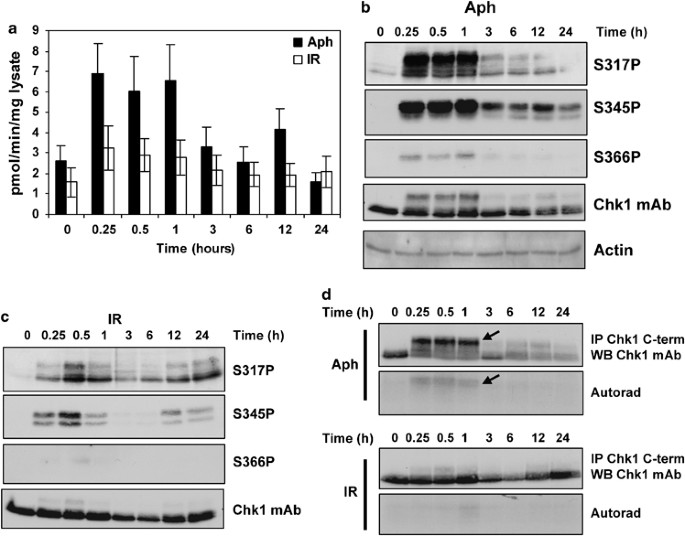
- Select a language for the TTS:
- UK English Female
- UK English Male
- US English Female
- US English Male
- Australian Female
- Australian Male
- Language selected: (auto detect) - EN
Play all audios:
ABSTRACT Chk1 is phosphorylated within its C-terminal regulatory domain by the upstream ATM/ATR kinases during checkpoint activation; however, how this modulates Chk1 function is poorly
understood. Here, we show that Chk1 kinase activity is rapidly stimulated in a cell-cycle phase-specific manner in response to both DNA damage and replication arrest, and that the extent and
duration of activation correlates closely with regulatory phosphorylation at serines (S) S317, S345 and S366. Despite their evident co-regulation, substitutions of individual Chk1
regulatory sites with alanine (A) residues have differential effects on checkpoint proficiency and kinase activation. Thus, whereas Chk1 S345 is essential for all functions tested, mutants
lacking S317 or S366 retain partial proficiency for G2/M and S/M checkpoint arrests triggered by DNA damage or replication arrest. These phenotypes reflect defects in Chk1 kinase induction,
as the mutants are either partially (317A and 366A) or completely (345A) resistant to kinase activation. Importantly, S345 phosphorylation is impaired in Chk1 S317A and S366A mutants,
suggesting that modification of adjacent SQ sites promotes this key regulatory event. Finally, we provide biochemical evidence that Chk1 catalytic activity is stimulated by a de-repression
mechanism. Access through your institution Buy or subscribe This is a preview of subscription content, access via your institution ACCESS OPTIONS Access through your institution Subscribe to
this journal Receive 50 print issues and online access $259.00 per year only $5.18 per issue Learn more Buy this article * Purchase on SpringerLink * Instant access to full article PDF Buy
now Prices may be subject to local taxes which are calculated during checkout ADDITIONAL ACCESS OPTIONS: * Log in * Learn about institutional subscriptions * Read our FAQs * Contact customer
support SIMILAR CONTENT BEING VIEWED BY OTHERS HISTONE H3 SERINE-57 IS A CHK1 SUBSTRATE WHOSE PHOSPHORYLATION AFFECTS DNA REPAIR Article Open access 22 August 2023 CRITICAL ROLE OF SMG7 IN
ACTIVATION OF THE ATR-CHK1 AXIS IN RESPONSE TO GENOTOXIC STRESS Article Open access 05 April 2021 CHK2 SUSTAINS PLK1 ACTIVITY IN MITOSIS TO ENSURE PROPER CHROMOSOME SEGREGATION Article Open
access 30 December 2024 REFERENCES * Adams KE, Medhurst AL, Dart DA, Lakin ND . (2006). Recruitment of ATR to sites of ionising radiation-induced DNA damage requires ATM and components of
the MRN protein complex. _Oncogene_ 25: 3894–3904. Article CAS Google Scholar * Bartek J, Lukas J . (2003). Chk1 and Chk2 kinases in checkpoint control and cancer. _Cancer Cell_ 3:
421–429. Article CAS Google Scholar * Bonilla CY, Melo JA, Toczyski DP . (2008). Colocalization of sensors is sufficient to activate the DNA damage checkpoint in the absence of damage.
_Mol Cell_ 30: 267–276. Article CAS Google Scholar * Chen P, Luo C, Deng Y, Ryan K, Register J, Margosiak S _et al_. (2000). The 1.7 A crystal structure of human cell cycle checkpoint
kinase Chk1: implications for Chk1 regulation. _Cell_ 100: 681–692. Article CAS Google Scholar * Chen Y, Sanchez Y . (2004). Chk1 in the DNA damage response: conserved roles from yeasts
to mammals. _DNA Repair (Amst)_ 3: 1025–1032. Article CAS Google Scholar * Cross DA, Smythe C . (1998). PD 98059 prevents establishment of the spindle assembly checkpoint and inhibits the
G2-M transition in meiotic but not mitotic cell cycles in Xenopus. _Exp Cell Res_ 241: 12–22. Article CAS Google Scholar * Dart DA, Adams KE, Akerman I, Lakin ND . (2004). Recruitment of
the cell cycle checkpoint kinase ATR to chromatin during S-phase. _J Biol Chem_ 279: 16433–16440. Article CAS Google Scholar * Feijoo C, Hall-Jackson C, Wu R, Jenkins D, Leitch J,
Gilbert DM _et al_. (2001). Activation of mammalian Chk1 during DNA replication arrest: a role for Chk1 in the intra-S phase checkpoint monitoring replication origin firing. _J Cell Biol_
154: 913–923. Article CAS Google Scholar * Gatei M, Sloper K, Sorensen C, Syljuasen R, Falck J, Hobson K _et al_. (2003). Ataxia-telangiectasia-mutated (ATM) and NBS1-dependent
phosphorylation of Chk1 on Ser-317 in response to ionizing radiation. _J Biol Chem_ 278: 14806–14811. Article CAS Google Scholar * Guo Z, Kumagai A, Wang SX, Dunphy WG . (2000).
Requirement for Atr in phosphorylation of Chk1 and cell cycle regulation in response to DNA replication blocks and UV-damaged DNA in Xenopus egg extracts. _Genes Dev_ 14: 2745–2756. Article
CAS Google Scholar * Jazayeri A, Falck J, Lukas C, Bartek J, Smith GC, Lukas J _et al_. (2006). ATM- and cell cycle-dependent regulation of ATR in response to DNA double-strand breaks.
_Nat Cell Biol_ 8: 37–45. Article CAS Google Scholar * Jiang K, Pereira E, Maxfield M, Russell B, Goudelock DM, Sanchez Y . (2003). Regulation of Chk1 includes chromatin association and
14-3-3 binding following phosphorylation on Ser-345. _J Biol Chem_ 278: 25207–25217. Article CAS Google Scholar * Kaneko YS, Watanabe N, Morisaki H, Akita H, Fujimoto A, Tominaga K _et
al_. (1999). Cell-cycle-dependent and ATM-independent expression of human Chk1 kinase. _Oncogene_ 18: 3673–3681. Article CAS Google Scholar * Katsuragi Y, Sagata N . (2004). Regulation of
Chk1 kinase by autoinhibition and ATR-mediated phosphorylation. _Mol Biol Cell_ 15: 1680–1689. Article CAS Google Scholar * Kramer A, Mailand N, Lukas C, Syljuasen RG, Wilkinson CJ, Nigg
EA _et al_. (2004). Centrosome-associated Chk1 prevents premature activation of cyclin-B-Cdk1 kinase. _Nat Cell Biol_ 6: 884–891. Article Google Scholar * Lee JH, Paull TT . (2005). ATM
activation by DNA double-strand breaks through the Mre11-Rad50-Nbs1 complex. _Science_ 308: 551–554. Article CAS Google Scholar * Liu Q, Guntuku S, Cui XS, Matsuoka S, Cortez D, Tamai K
_et al_. (2000). Chk1 is an essential kinase that is regulated by Atr and required for the G(2)/M DNA damage checkpoint. _Genes Dev_ 14: 1448–1459. Article CAS Google Scholar * Lupardus
PJ, Byun T, Yee MC, Hekmat-Nejad M, Cimprich KA . (2002). A requirement for replication in activation of the ATR-dependent DNA damage checkpoint. _Genes Dev_ 16: 2327–2332. Article CAS
Google Scholar * Mailand N, Bekker-Jensen S, Bartek J, Lukas J . (2006). Destruction of Claspin by SCFbetaTrCP restrains Chk1 activation and facilitates recovery from genotoxic stress. _Mol
Cell_ 23: 307–318. Article CAS Google Scholar * Matsuoka S, Rotman G, Ogawa A, Shiloh Y, Tamai K, Elledge SJ . (2000). Ataxia telangiectasia-mutated phosphorylates Chk2 _in vivo_ and _in
vitro_. _Proc Natl Acad Sci USA_ 97: 10389–10394. Article CAS Google Scholar * Myers JS, Cortez D . (2006). Rapid activation of ATR by ionizing radiation requires ATM and Mre11. _J Biol
Chem_ 281: 9346–9350. Article CAS Google Scholar * Niida H, Katsuno Y, Banerjee B, Hande MP, Nakanishi M . (2007). Specific role of Chk1 phosphorylations in cell survival and checkpoint
activation. _Mol Cell Biol_ 27: 2572–2581. Article CAS Google Scholar * Oe T, Nakajo N, Katsuragi Y, Okazaki K, Sagata N . (2001). Cytoplasmic occurrence of the Chk1/Cdc25 pathway and
regulation of Chk1 in Xenopus oocytes. _Dev Biol_ 229: 250–261. Article CAS Google Scholar * Peschiaroli A, Dorrello NV, Guardavaccaro D, Venere M, Halazonetis T, Sherman NE _et al_.
(2006). SCFbetaTrCP-mediated degradation of Claspin regulates recovery from the DNA replication checkpoint response. _Mol Cell_ 23: 319–329. Article CAS Google Scholar * Puc J, Keniry M,
Li HS, Pandita TK, Choudhury AD, Memeo L _et al_. (2005). Lack of PTEN sequesters CHK1 and initiates genetic instability. _Cancer Cell_ 7: 193–204. Article CAS Google Scholar * Shimada M,
Niida H, Zineldeen DH, Tagami H, Tanaka M, Saito H _et al_. (2008). Chk1 is a histone H3 threonine 11 kinase that regulates DNA damage-induced transcriptional repression. _Cell_ 132:
221–232. Article CAS Google Scholar * Smith GC, Cary RB, Lakin ND, Hann BC, Teo SH, Chen DJ _et al_. (1999). Purification and DNA binding properties of the ataxia-telangiectasia gene
product ATM. _Proc Natl Acad Sci USA_ 96: 11134–11139. Article CAS Google Scholar * Smits VA, Reaper PM, Jackson SP . (2006). Rapid PIKK-dependent release of Chk1 from chromatin promotes
the DNA-damage checkpoint response. _Curr Biol_ 16: 150–159. Article CAS Google Scholar * Suzuki K, Kodama S, Watanabe M . (1999). Recruitment of ATM protein to double strand DNA
irradiated with ionizing radiation. _J Biol Chem_ 274: 25571–25575. Article CAS Google Scholar * Traven A, Heierhorst J . (2005). SQ/TQ cluster domains: concentrated ATM/ATR kinase
phosphorylation site regions in DNA-damage-response proteins. _Bioessays_ 27: 397–407. Article CAS Google Scholar * Wilsker D, Petermann E, Helleday T, Bunz F . (2008). Essential function
of Chk1 can be uncoupled from DNA damage checkpoint and replication control. _Proc Natl Acad Sci USA_ 105: 20752–20757. Article CAS Google Scholar * Zachos G, Rainey MD, Gillespie DA .
(2003). Chk1-deficient tumour cells are viable but exhibit multiple checkpoint and survival defects. _EMBO J_ 22: 713–723. Article CAS Google Scholar * Zachos G, Rainey MD, Gillespie DA .
(2005). Chk1-dependent S-M checkpoint delay in vertebrate cells is linked to maintenance of viable replication structures. _Mol Cell Biol_ 25: 563–574. Article CAS Google Scholar * Zhang
YW, Otterness DM, Chiang GG, Xie W, Liu YC, Mercurio F _et al_. (2005). Genotoxic stress targets human Chk1 for degradation by the ubiquitin-proteasome pathway. _Mol Cell_ 19: 607–618.
Article CAS Google Scholar * Zhao H, Piwnica-Worms H . (2001). ATR-mediated checkpoint pathways regulate phosphorylation and activation of human Chk1. _Mol Cell Biol_ 21: 4129–4139.
Article CAS Google Scholar * Zou L, Elledge SJ . (2003). Sensing DNA damage through ATRIP recognition of RPA-ssDNA complexes. _Science_ 300: 1542–1548. Article CAS Google Scholar
Download references ACKNOWLEDGEMENTS We thank Dr Frank Kozielski for his comments on the manuscript. This work was supported by Cancer Research UK (CR-UK). AUTHOR INFORMATION AUTHORS AND
AFFILIATIONS * Beatson Institute for Cancer Research, Garscube Estate, Glasgow, UK M Walker, E J Black, V Oehler, D A Gillespie & M T Scott * Faculty of Biomedical and Life Sciences,
University of Glasgow, Glasgow, UK D A Gillespie Authors * M Walker View author publications You can also search for this author inPubMed Google Scholar * E J Black View author publications
You can also search for this author inPubMed Google Scholar * V Oehler View author publications You can also search for this author inPubMed Google Scholar * D A Gillespie View author
publications You can also search for this author inPubMed Google Scholar * M T Scott View author publications You can also search for this author inPubMed Google Scholar CORRESPONDING AUTHOR
Correspondence to M T Scott. ADDITIONAL INFORMATION Supplementary Information accompanies the paper on the Oncogene website (http://www.nature.com/onc) SUPPLEMENTARY INFORMATION
SUPPLEMENTARY FIGURES 1 (DOC 564 KB) SUPPLEMENTARY FIGURES 2 (DOC 26 KB) SUPPLEMENTARY METHODS (DOC 28 KB) RIGHTS AND PERMISSIONS Reprints and permissions ABOUT THIS ARTICLE CITE THIS
ARTICLE Walker, M., Black, E., Oehler, V. _et al._ Chk1 C-terminal regulatory phosphorylation mediates checkpoint activation by de-repression of Chk1 catalytic activity. _Oncogene_ 28,
2314–2323 (2009). https://doi.org/10.1038/onc.2009.102 Download citation * Received: 27 February 2009 * Revised: 23 March 2009 * Accepted: 24 March 2009 * Published: 04 May 2009 * Issue
Date: 18 June 2009 * DOI: https://doi.org/10.1038/onc.2009.102 SHARE THIS ARTICLE Anyone you share the following link with will be able to read this content: Get shareable link Sorry, a
shareable link is not currently available for this article. Copy to clipboard Provided by the Springer Nature SharedIt content-sharing initiative KEYWORDS * Chk1 * ATR * kinase activity








